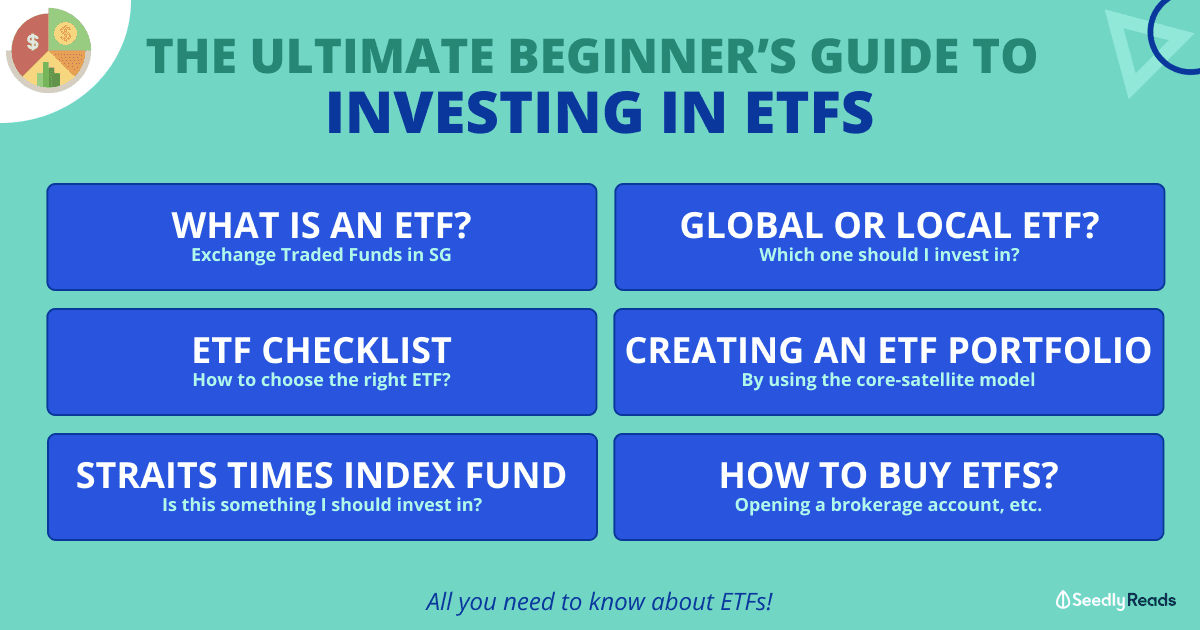A Beginner's Guide On How To Invest in ETFs in Singapore
So, you’ve opened your CDP account and have an online brokerage account ready to start your (DIY) investing journey…
But like many beginners, you’re probably stumped upon facing the gazillion investment vehicles out there.

Well, fret not!
If you’ve read our articles, you’ll know that building a diversified portfolio is key when it comes to investing.
And while you can pick individual stocks to form your portfolio, you might want to consider Exchange Traded Funds (ETFs) that give you instant access to a whole basket of stocks for instant diversification.
So here’s the ultimate guide on how to pick your first ETF and how to invest in them!
TL;DR: A Beginner’s Guide On How To Invest in ETFs in Singapore

What is an ETF?

An ETF, or exchange-traded fund, is an investment that commonly tracks the performance of an underlying index.
By investing in an ETF, investors can get access to a range of companies within the ETF instead of trying to pick individual companies. They are traded on a stock exchange and can be purchased the same way you would for any stock.
What Should I Look Out For When Choosing Which ETF To Invest In?
Investing in ETFs may seem like a safe choice, especially when you’re buying a variety of different products. But with more than 4,000 ETFs around the globe spread, it’s tough to narrow them down.
Luckily, we have come up with some ways that you can go about choosing the right ETF to invest in.

When choosing the right ETF, you will have to first consider evaluating the market, taking note of the possible economic changes that can happen and how it affects various industries.
Next, take a good look at your investment portfolio. Find out what kind of investor you are, and how the addition of this ETF will affect your portfolio.
Most importantly, you have to evaluate the index and ETF, and ask yourself these key questions:
- What is the ETF tracking?
- What is the investment objective of this ETF?
- How frequently does the ETF report their holdings?
- What are the holding and weightings of the ETF?
Furthermore, you can also evaluate the ETF by looking at the expense ratio, liquidity, tracking error and bid-ask spread.
Straits Times Index (STI) ETF
If you’re a Singaporean, you would know that one of the most popular ETFs would be the Straits Times Index (STI) ETF, a stock market index made up of the top 30 largest and most liquid companies listed in Singapore. Company stocks that constitute the STI ETF include DBS, OCBC, UOB, Singtel, Jardine Matheson, Capitaland, Keppel Corporation and more.
If you decide to trade in the STI ETF, you realise that there are two of it to choose from:
- SPDR STI ETF (SGX: ES3)
- Nikko AM STI ETF (SGX: G3B)
Here’s a comparison article to help you decide on which is better to invest in:
How Do I Go About Creating My ETF Portfolio?
Just as there are many types of ETFs in the various markets, there are also many ways to build a portfolio with ETFs. One method used to construct an ETF Portfolio would be the Core-Satellite Investing method. This involves the construction of two different portions: the core and the satellite.
The core portfolio should comprise of passive investments that track major market indices. Additional positions known as satellites are added to the portfolio. Investments found in the satellite portion are actively managed.
Core Portfolio

The Core Portfolio should generally be invested in ETFs that give a diversified exposure to major global economies and markets like the United States, Europe, and Asia.
These assets are:
- Broad-based
- Not too risky
- Long-term investments (10-year horizon given how each economic cycle lasts approximately that amount of time)
and will form the foundation of your ETF portfolio.
Satellite Portfolio
Assets found in the Satellite Portfolio are invested in higher-risk assets and should be capped at a maximum of 20% of your asset allocation for ETFs.
With this strategy, you open up the opportunity to access higher-risk assets that may have potentially higher returns. At the same time, you will be able to limit volatility, and have tighter control over your cost!
Should I Consider Local, Or Global ETFs?
Buying ETFs is a great beginner’s investment strategy. However, should you choose a local ETF like the STI ETF? Or a global one such as the Vanguard VOO ETF, a US-based ETF that tracks the S&P500?
While there are some who strongly believe in investing in local ETFs, here’s an alternative view on why you should consider Low-Cost Global ETFs.

Apart from being lower cost in general, global ETFs give you international exposure and possibly more diversification if you choose to invest in globally diversified ETFs like the SPDR® MSCI World UCITS ETF (SWRD).
However, do note that if you were to invest in US ETFs, there is a 30% withholding tax on dividends. One workaround is to invest in Ireland-domiciled ETFs which reduces that amount to 15%.
Here are a couple articles that you may find useful if you are looking to invest in the S&P 500 or other global ETFs:
How Do I Start Buying ETFs in Singapore?
If you are totally new to investing, the very first step that we advocate would be to open a CDP and Brokerage account. Here’s a step-by-step guide on how to do it.
Once you have successfully opened both accounts, an ETF can be purchased just like any stock.
Next, you can decide if you would like to invest via lump-sum investing, or dollar-cost averaging. Here are the pros and cons of the two explained in this article:
For those who are looking to start small and invest a few hundred each month, you can also consider these investment platforms, which include investing in ETFs as well!
Still unsure?
Ask your questions on the Seedly Community!
Related Articles
Advertisement












